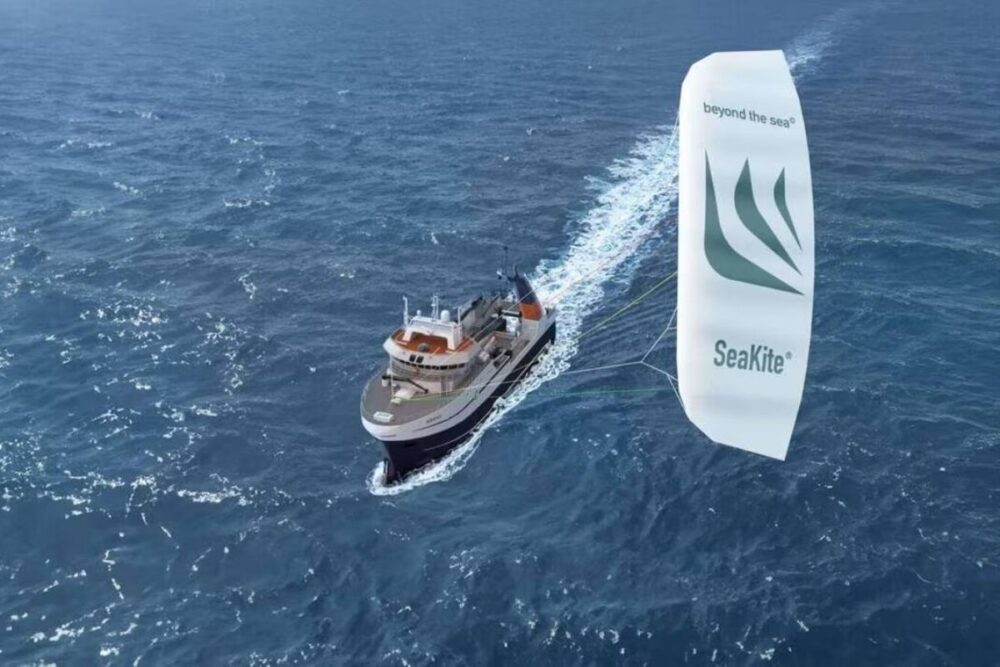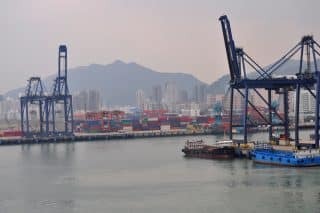As the maritime industry faces mounting pressure to reduce its carbon footprint, French startup Beyond the Sea is turning to the wind for a solution. The company is pioneering automated kite propulsion systems that promise to drastically cut emissions from commercial ships. This week, at the Third United Nations Ocean Conference (UNOC-3) in Nice, Beyond the Sea is preparing to unveil one of the most ambitious and scalable clean propulsion solutions on the market. In an exclusive interview with Marc Thienpont, the company’s current CEO, we explored how Beyond the Sea aims to revolutionize maritime shipping through its innovative technology.
Beyond the Sea was founded in 2014 by Yves Parlier, an iconic sailor known for his daring Vendée Globe participations and extraordinary feats at sea. Today, his company is on a mission to decarbonize the global shipping industry using automated wind propulsion via high-performance kites.
The startup gained major recognition in December 2021, when it secured €1 million in funding from climate-focused investment fund Time for the Planet (now Team for the Planet).
An Urgent Environmental and Economic Imperative
The maritime sector is responsible for approximately 3% of global CO₂ emissions. And this share could grow as international trade expands.
Marc Thienpont, CEO of Beyond the Sea, explains:
“If the global merchant fleet were a country, it would be the sixth-largest emitter of CO₂ on the planet.”
To address this critical challenge, Beyond the Sea is developing wind-assist technologies that can reduce fuel consumption and greenhouse gas emissions by 20% to 40%, depending on the vessel’s type, size, and route.
A Scalable, Compatible, and Compact Solution for Greener Shipping
The idea is both elegantly simple and technologically sophisticated: use large, automated kites to assist ship propulsion, cutting fossil fuel consumption and drastically reducing greenhouse gas emissions. These modular systems can be retrofitted onto a wide variety of vessels—from pleasure boats and fishing trawlers to cargo ships and military vessels—without the need for major structural changes.
For Marc Thienpont,:
“With this kite-based propulsion solution, we can significantly decarbonize the global fleet—including ships that are already in service. That’s what we call retrofitting. A ship typically has a lifespan of 20 to 25 years. Today, there are about 100,000 merchant ships operating worldwide. But global shipyards can only produce around 1,500 new vessels per year. Even if we replaced 1,500 ships annually for the next 20 years, we’d only reach about 30,000—well short of what’s needed to meet climate targets. Retrofitting isn’t just an option; it’s a necessity.”
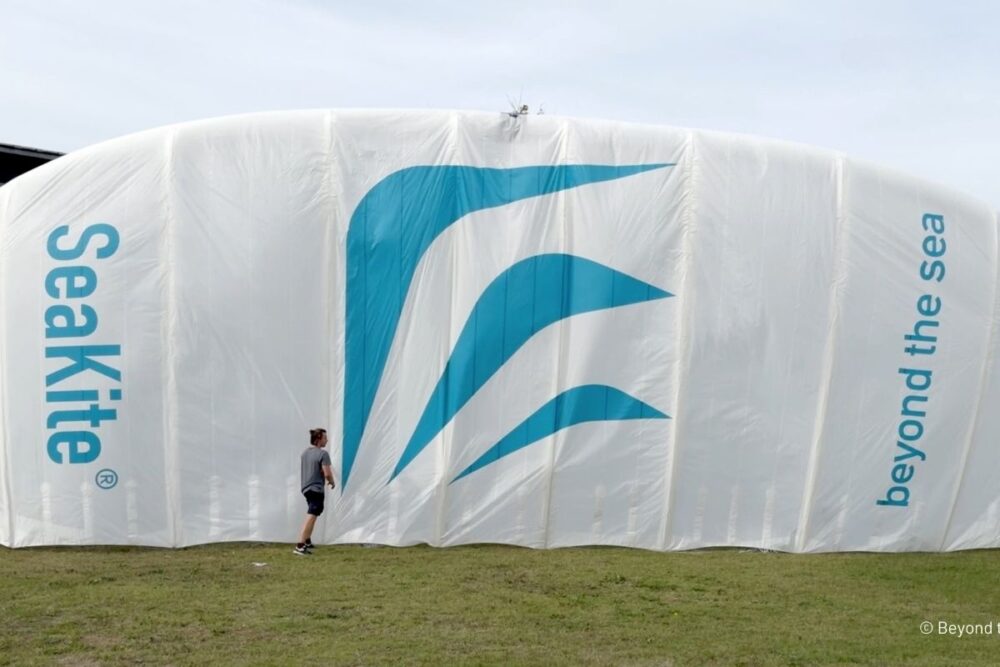
Two Breakthrough Kite Systems Already in Action
Beyond the Sea currently offers two main kite systems, each tailored to different ship sizes and use cases:
The LibertyKite® (10–80 m²) is designed for leisure boats and small vessels. It is already in commercial use (over 300 units have been sold). It is for example used by 70% of Vendée Globe race yachts as an emergency propulsion system.
The SeaKite® (50–200 m²) is built for larger commercial vessels and is currently being deployed in pilot programs. Features include large kites (up to 200 m²), high-strength lines, a deck-mounted winch and sensor system and an AI-powered autopilot to control flight patterns.
How Does It Work?
The system launches a large kite using a simple deployment and recovery mechanism. Once airborne, the kite performs dynamic flight maneuvers—similar to how a kitesurfer “pumps” their kite to generate lift. Unlike traditional sails that remain static, the kite moves actively within a “wind window,” performing figure-eights, S-curves, or even full 360° loops.
“Traditional sails are fixed. The ship must align itself to the wind. But a kite moves—it creates its own apparent wind, enabling it to generate up to ten times more power than a static sail.”
For comparison, the historic sailing ship Belem, which carried the Olympic flame to Marseille last year, has 3,000 m² of sails. But when sailing downwind, only the front sails are effective—bringing total usable sail area down to about 1,000 m².
“In that same wind, an 18 m² kite could generate equivalent thrust—illustrating the extreme efficiency of kite propulsion.”
Tests have shown that these kites can deliver a traction force of 100 kg per square meter. That means a 100 m² kite could pull up to 10 tons—and real-world tests are already exceeding these expectations.
To meet growing demand, Beyond the Sea is developing a third kite system specifically designed for mid-sized vessels. A 400 m² SeaKite is currently under development, with rollout expected by 2026. This next-gen system will generate several tons of thrust. It will be a game-changer for large commercial fleets and enable scalable decarbonization across global shipping.

Technical Details: The Engineering Behind Kite-Powered Propulsion
How can a kite generate enough power to pull a 100,000-ton cargo ship? According to Marc Thienpont, it all starts with aerospace-inspired design.
The company worked closely with aeronautical engineers to develop a highly specialized wing structure known as a “tube-shaped” or “inflatable leading-edge” wing. It is similar in concept to an airplane wing, but optimized for dynamic kite flight. The kite features internal battens for structure and a flat profile to maximize lift and stability.
“The wing’s shape is relatively flat, and it’s piloted more like the flaps on an aircraft than the tips of a traditional kite,” explains Thienpont.
To achieve the power-to-weight ratio needed for commercial shipping, Beyond the Sea also uses high-performance textiles and reinforced stitching methods. These innovations ensure that the kite remains lightweight yet durable—capable of withstanding the harsh conditions of ocean travel while delivering powerful propulsion.
The kite system is guided by an autonomous flight controller that continuously adjusts to wind conditions in real time. But Beyond the Sea is going further by integrating artificial intelligence.
“We’re training the AI to not only adapt to changing wind patterns but also to optimize the kite’s trajectory within the flight window to extract the maximum power,” says Thienpont.
This means the system doesn’t just follow the wind—it actively seeks out the zones of highest aerodynamic efficiency to generate more thrust with less effort.
What truly sets Beyond the Sea apart from competitors like Airseas is its lightweight, efficient launch and recovery system. Traditional kite systems for shipping often involve multi-ton mechanisms that require heavy deck installations. Beyond the Sea’s approach is different:
“Our system reshapes the kite before launch—compressing it like a child’s kite—using a single line. Once it reaches cruising altitude, it regains its full aerodynamic form and begins generating power.”
This technique allows for faster deployment, less onboard hardware and easier integration into existing vessels. Once deployed, the kite can fly at the zenith (directly above the ship) or shift into dynamic flight patterns like figure-eights, maximizing its energy output.
Retrofit: Seamless Integration for Existing Ships
One of the key advantages of Beyond the Sea’s kite propulsion system is its ability to retrofit seamlessly onto existing vessels—without major structural overhauls. According to CEO Marc Thienpont, the installation is straightforward, modular, and minimally invasive.
At the core of the retrofit system is a 9–11 meter retractable mast, made of carbon fiber or steel. It’s only deployed during kite launch and recovery.
The kite is controlled by versatile winches that can be installed flexibly across the ship, depending on the layout. Their positioning is determined using pulleys and guide systems tailored to the vessel’s configuration.
A load-bearing platform with integrated sensors is typically mounted toward the ship’s bow. The system requires only a clear, unobstructed area for full functionality—something most ships already have.
For large commercial ships, the integration process is especially efficient. These vessels usually feature a technical room beneath the forward deck, directly under the mooring winches. This space is already structurally reinforced and designed to handle heavy loads, such as anchor chains and towing gear:
“Because this zone is engineered to absorb high tension from anchoring and mooring operations, it’s perfectly suited to support the kite system’s traction forces—without requiring structural reinforcements,” explains Thienpont.
Once installed, the system is connected to the ship’s electrical grid. The power requirement is minimal, as the kite system is designed to be energy-efficient, prioritizing fuel savings over electrical demand.
It also integrates with the ship’s existing navigation systems, and is operated through an intuitive Human-Machine Interface (HMI). This dashboard consolidates all controls and real-time data, including kite status, wind conditions, power output and system diagnostics.
Beyond the Sea also integrates AI in the system for example for anomaly detection to identify early signs of failure—such as reduced lift or line tension irregularities and for proactive automation, allowing the autopilot to adapt dynamically to shifting flight conditions.
“If a traction line begins to weaken or the kite shows signs of losing lift, the AI detects that the flight window is shrinking. The autopilot then takes action before these issues impact performance,” says Thienpont.
This predictive behavior enhances both safety and system uptime, ensuring reliable performance even in challenging conditions.
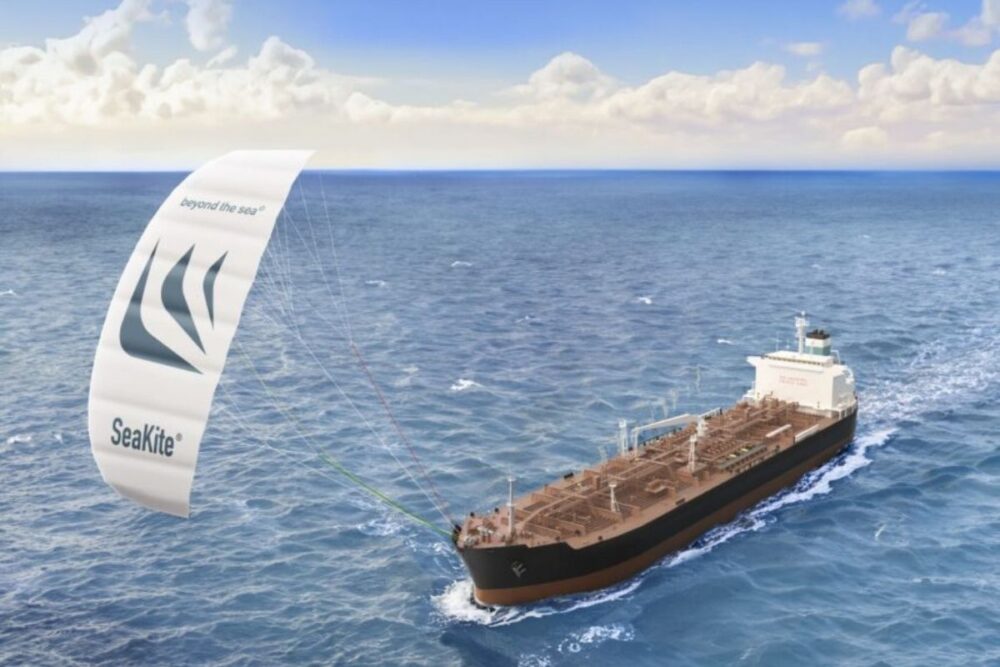
Applications
Who is this technology for? According to Beyond the Sea, the answer is simple: everyone. From massive container ships to small fishing vessels, any ship looking to reduce its fuel consumption and carbon emissions stands to benefit.
“To make a real impact on decarbonization, we need to target the largest emitters—big commercial vessels. But we also need to serve everyone. Fishing boats face fuel and emissions challenges that are proportionally just as critical. And there are millions of them worldwide. That’s a huge market for us.”
Marc estimates that kite-assisted propulsion can reduce emissions depending on several factors such as the ship size and hull shape, transit time flexibility or route wind conditions. For example, transatlantic routes benefit from strong trade winds—ideal for kite systems. In contrast, Asia-Europe routes typically experience lighter winds, resulting in lower but still valuable gains.
Real-World Deployments Accelerating
After over a decade of R&D, Beyond the Sea is now entering full deployment mode, with high-profile trials and partnerships:
- French Navy and Les Abeilles International are testing SeaKite systems on tugboats Jason and Abeille Méditerranée.
- In May 2025, a 500 m² SeaKite was installed on the Forbin for full-scale validation. This LPG tanker is operated by Geogas Maritime and chartered by TotalEnergies.
- Global shipping firm Ultranav is partnering with Beyond the Sea to retrofit its fleet, beginning with a 100 m² kite in 2025, scaling to 400 m² by 2026–2027.
- Cap Bourbon, a fishing company, will equip its longliner Cap Kersaint with a 100 m² SeaKite as part of its transition strategy.
Return on Investment and Regulatory Drivers
What’s the ROI? On Reunion Island, Beyond the Sea signed a contract with a fishing operator where the payback period is just 18 months.
“They’ll save on fuel and avoid costly refueling at remote ports like the Kerguelen Islands,” says Thienpont.
Beyond the Sea’s technology is also attracting a growing number of clients who are motivated by shifting regulatory and market dynamics. In Europe, carbon taxes on maritime emissions are already in effect, directly impacting operating costs. The International Maritime Organization (IMO) is actively negotiating a framework for global carbon pricing, with a pivotal vote on a carbon levy expected in October. This upcoming policy aims to reduce greenhouse gas emissions across the industry, while simultaneously offsetting the added costs of transitioning to low- or zero-emission fuels. The broader goal is to accelerate the sector’s shift toward more sustainable practices. An evolution that Beyond the Sea’s kite propulsion technology is uniquely positioned to support.
“Fuel will become more expensive and heavily taxed,” Thienpont adds. “The financial pressure from fuel regulations and emissions standards will keep increasing. Our clients know this is coming, and they’re getting ahead of it.”
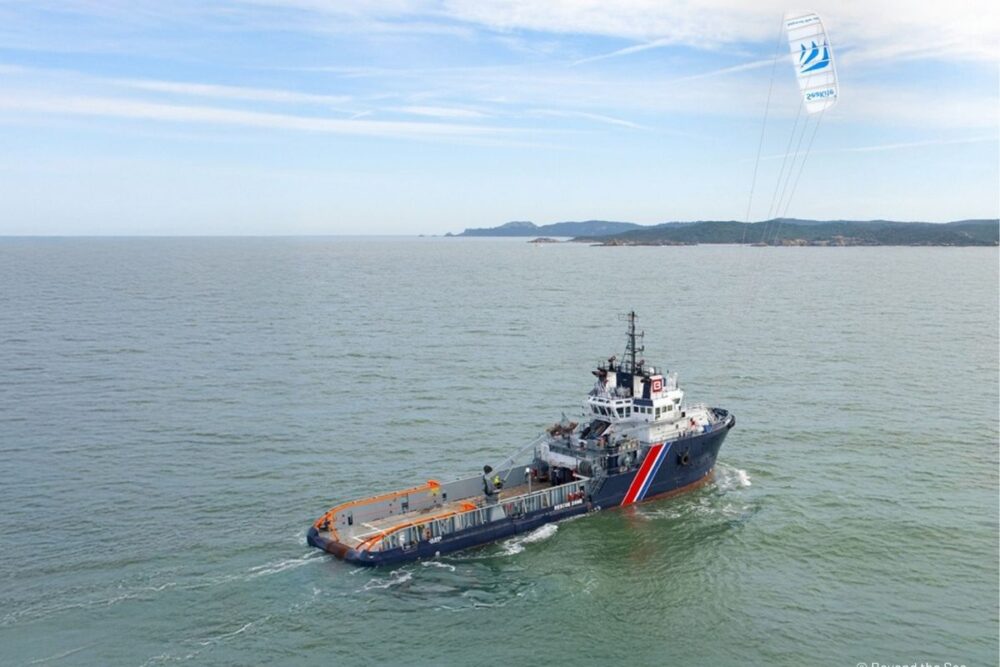
Public Demonstrations and Future Outlook
During the United Nations Ocean Conference (UNOC3) in Nice, the tugboat Jason—operated by Les Abeilles International and chartered by the French Navy—will conduct a live demonstration between Nice and Monaco.
“This is about visibility—showing that the technology is real, mature, and already working,” says Thienpont.
Looking ahead, Beyond the Sea is charting a path toward broader industry transformation. The company plans to collaborate directly with shipbuilders to integrate its kite propulsion systems into new vessels from the design stage.
At the same time, the start-up is working to standardize its technology. This move will facilitate faster adoption across fleets and enable large-scale deployment in commercial shipping.
In an open letter, Yves Parlier calls on political leaders, ocean advocates, and the maritime industry to stop overlooking one of the most obvious tools for ocean preservation: the power of the wind:
“Wind propulsion — free, clean, abundant, and globally accessible — has the potential to cut fuel consumption by 20–30% immediately with existing technology. So why is it still so marginal in public funding and regulatory roadmaps? What’s missing is not innovation, but direction and political will.”
He urges delegates at UNOC-3 to make wind propulsion a cornerstone of maritime decarbonization, calling for carbon tax revenues to be redirected toward proven wind-assisted technologies. A recent bill proposed in France’s National Assembly to accelerate wind-powered shipping — backed by 50 MPs — offers a hopeful sign but must be adopted quickly to meet climate targets.
